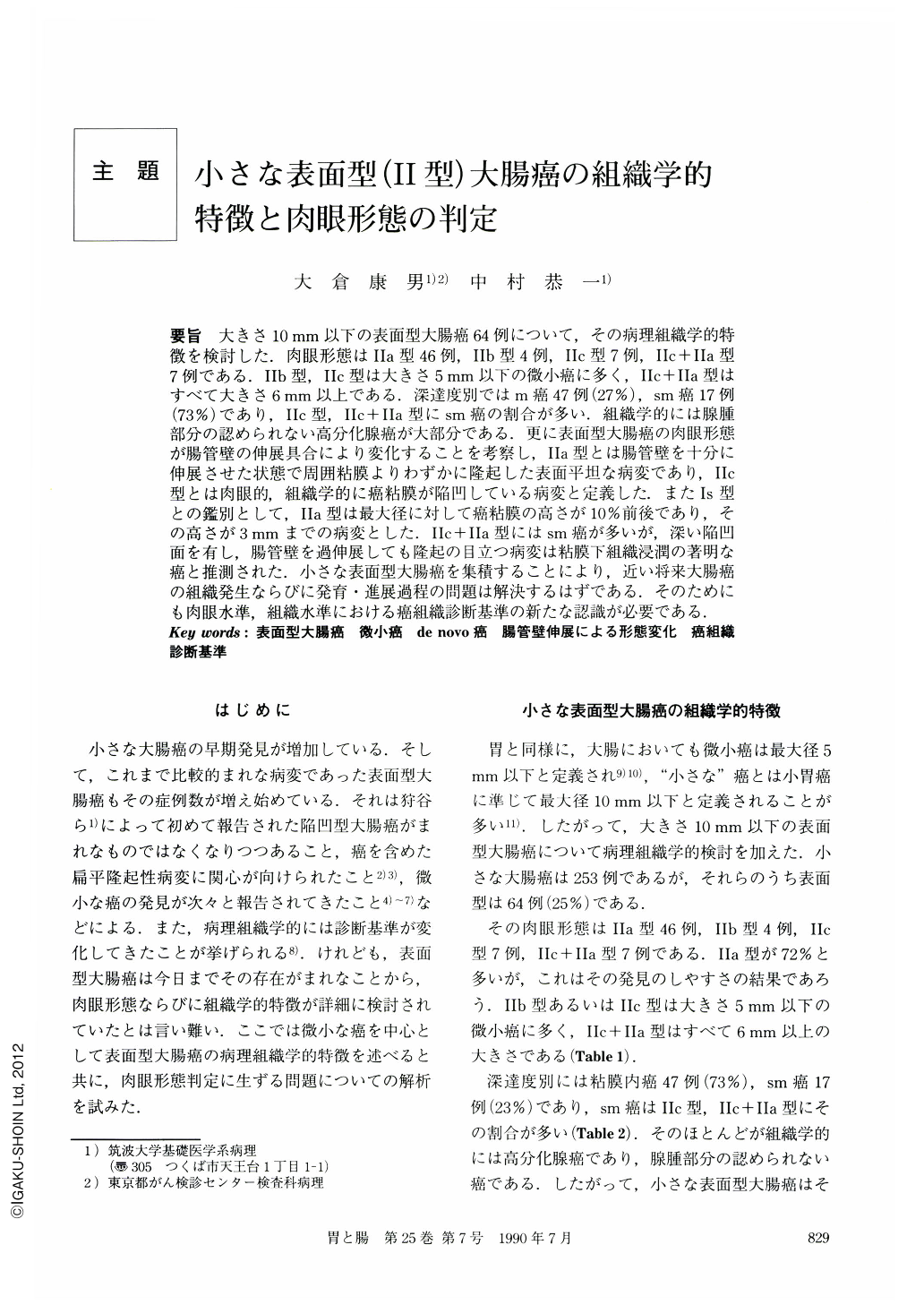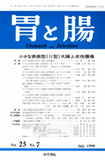Japanese
English
- 有料閲覧
- Abstract 文献概要
- 1ページ目 Look Inside
要旨 大きさ10mm以下の表面型大腸癌64例について,その病理組織学的特徴を検討した.肉眼形態はⅡa型46例,Ⅱb型4例,Ⅱc型7例,Ⅱc+Ⅱa型7例である.Ⅱb型,Ⅱc型は大きさ5mm以下の微小癌に多く,Ⅱc+Ⅱa型はすべて大きさ6mm以上である.深達度別ではm癌47例(27%),sm癌17例(73%)であり,Ⅱc型,Ⅱc+Ⅱa型にsm癌の割合が多い.組織学的には腺腫部分の認められない高分化腺癌が大部分である.更に表面型大腸癌の肉眼形態が腸管壁の伸展具合により変化することを考察し,Ⅱa型とは腸管壁を十分に伸展させた状態で周囲粘膜よりわずかに隆起した表面平坦な病変であり,Ⅱc型とは肉眼的,組織学的に癌粘膜が陥凹している病変と定義した.またIs型との鑑別として,Ⅱa型は最大径に対して癌粘膜の高さが10%前後であり,その高さが3mmまでの病変とした.Ⅱc+Ⅱa型にはsm癌が多いが,深い陥凹面を有し,腸管壁を過伸展しても隆起の目立つ病変は粘膜下組織浸潤の著明な癌と推測された.小さな表面型大腸癌を集積することにより,近い将来大腸癌の組織発生ならびに発育・進展過程の問題は解決するはずである.そのためにも肉眼水準,組織水準における癌組織診断基準の新たな認識が必要である.
From the view-point of the histogenesis of colorectal carcinomas, it has been suspected that the target lesions for detecting carcinomas in the early phase are de novo carcinomas of the superficial type measuring less than 1 cm in the largest diameter. Recently, small colorectal carcinomas of the superficial type have frequently been disclosed endoscopically in Japan. Using 64 cases of small colorectal carcinomas of the superficial type less than 1 cm in the largest diameter, macroscopic and microscopic features were examined.
Macroscopically, 46 cases were superficial elevated type (Type Ⅱa), 4 cases were superficial flat type (Type Ⅱb), 7 cases were superficial depressed type (Type Ⅱc), and 7 cases were mixed type (Type Ⅱc+Ⅱa). Most cases (72%) were Type Ⅱa carcinomas. Type Ⅱb and Ⅱc carcinomas were mostly minute ones less than 5 mm in the largest diameter. In contrast with this, most cases of Type Ⅱc+Ⅱa carcinomas were above 6 mm in the largest diameter. In invasion depth, 47 cases (73%) were intramucosal carcinomas and 17 cases (23%) were submucosal infiltrating carcinomas. The majority of submucosal infiltrating carcinomas were Type Ⅱc and Type Ⅱc+Ⅱa. By microscopic examination using the objective indices of grade of atypicalities (ING and ISA), almost all cases of small colorectal carcinomas of the superficial type were de novo without the adenomatous component. These atypicalities were much different (in structure and cellular level) from the atypicalities of small benign adenomas.
The macroscopic appearance of small colorectal carcinomas of the superficial type changes according to the various grades of extension of the bowel wall (Figs. 7, 9, 11). To decide the macroscopic type of carcinoma of the superficial type, it is important to extend the bowel wall sufficiently. In this extended condition, Type Ⅱa carcinoma can be identified as slightly elevated lesion with flat smooth surfaces, and Type Ⅱc carcinomas appear as well-depressed lesions both macroscopically and microscopically. To distinguish these from the sessile type (Type Is), the histopathological standard of Type Ⅱa is that the height in comparison with the largest diameter is about 10%, and the height is less than 3 mm. Also, if carcinomas of Type Ⅱc+Ⅱa remain as distinctly elevated lesions when the bowel wall is fully extended, it should be suspected that they are carcinomas with massive submucosal infiltration. So it is important to discern this change of macroscopic appearance of colorectal carcinomas of the superficial type.
To accumulate data concerning minute colorectal carcinomas of the superficial type will enable us, in the near future, to understand their histogenesis and developmental process.

Copyright © 1990, Igaku-Shoin Ltd. All rights reserved.


